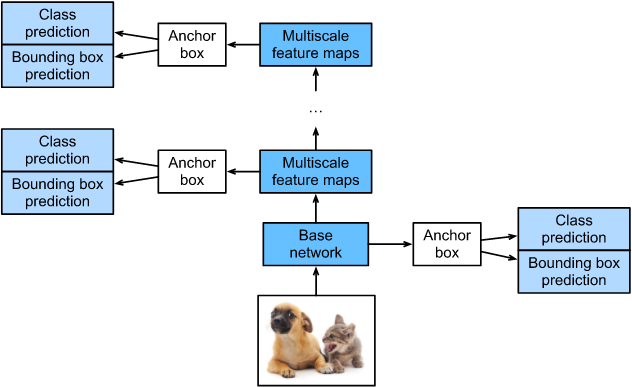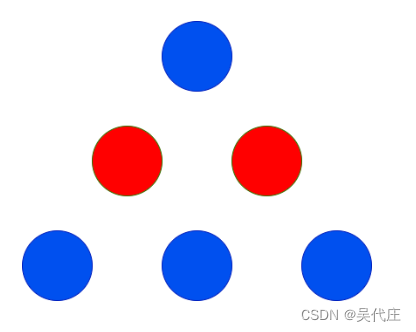摘要:
记录MindSpore AI框架使用SSD目标检测算法对图像内容识别的过程、步骤和方法。包括环境准备、下载数据集、数据采样、数据集加载和预处理、构建模型、损失函数、模型训练、模型评估等。
一、概念
1.模型简介
SSD目标检测算法
Single Shot MultiBox Detector
使用Nvidia Titan X在VOC 2007测试集上
输入尺寸300x300的网络
达到74.3%mAP(mean Average Precision)以及59FPS;
输入尺寸512x512的网络
达到了76.9%mAP
超越当时最强的Faster RCNN(73.2%mAP)
SSD目标检测主流算法分成可以两个类型:
two-stage方法:RCNN系列
通过算法产生候选框,然后再对这些候选框进行分类和回归。
one-stage方法:YOLO和SSD
直接通过主干网络给出类别位置信息,不需要区域生成。
SSD是单阶段的目标检测算法
卷积神经网络提取特征
取不同的特征层进行检测输出
多尺度检测方法。
检测特征层使用3 × 3卷积
通道变换
anchor策略
预设不同长宽比例的anchor
每个输出特征层预测多个检测框(4或者6)
浅层用于检测小目标
深层用于检测大目标
SSD框架图:

。
2.模型结构
SSD基础模型为VGG16
新增卷积层获得更多特征图用于检测
SSD网络结构图。

上层是SSD模型
多尺度特征图做检测
下层是YOLO模型
两种单阶段目标检测算法的比较:
SSD卷积提取特征
检测网络3 ×× 3卷积得到输出
卷积通道数=(anchor数量*(类别数量+4))
anchor数量
类别数量
SSD与YOLO的不同
SSD 通过卷积得到最后的边界框
YOLO通过全连接得到一维向量
拆解向量得到最终的检测框
3.模型特点
(1)多尺度检测
SSD使用多个特征层
特征层的尺寸分别是
38 × 38
19 × 19
10 × 10
5 × 5
3 × 3
1 × 1
大尺度特征图检测小物体
小尺度特征图检测大物体
(2)卷积检测
SSD采用卷积提取不同特征图的检测结果
m × n × p形状特征图采用3 × 3 × p小卷积核得到检测值
(3)预设anchor
SSD预设边界框anchor
预测框尺寸anchor指导微调
二、环境准备
%%capture captured_output
# 实验环境已经预装了mindspore==2.2.14,如需更换mindspore版本,可更改下面mindspore的版本号
!pip uninstall mindspore -y
!pip install -i https://pypi.mirrors.ustc.edu.cn/simple mindspore==2.2.14
# 查看当前 mindspore 版本
!pip show mindspore输出:
Name: mindspore
Version: 2.2.14
Summary: MindSpore is a new open source deep learning training/inference framework that could be used for mobile, edge and cloud scenarios.
Home-page: https://www.mindspore.cn
Author: The MindSpore Authors
Author-email: contact@mindspore.cn
License: Apache 2.0
Location: /home/nginx/miniconda/envs/jupyter/lib/python3.9/site-packages
Requires: asttokens, astunparse, numpy, packaging, pillow, protobuf, psutil, scipy
Required-by: 安装实验所需模块:
mindspore、download、pycocotools、opencv-python
!pip install -i https://pypi.mirrors.ustc.edu.cn/simple pycocotools==2.0.7 输出:
Looking in indexes: https://pypi.mirrors.ustc.edu.cn/simple
Collecting pycocotools==2.0.7
Downloading https://mirrors.bfsu.edu.cn/pypi/web/packages/19/93/5aaec888e3aa4d05b3a1472f331b83f7dc684d9a6b2645709d8f3352ba00/pycocotools-2.0.7-cp39-cp39-manylinux_2_17_aarch64.manylinux2014_aarch64.whl (419 kB)
━━━━━━━━━━━━━━━━━━━━━━━━━━━━━━━━━━━━━━ 419.9/419.9 kB 18.7 MB/s eta 0:00:00
Requirement already satisfied: matplotlib>=2.1.0 in /home/nginx/miniconda/envs/jupyter/lib/python3.9/site-packages (from pycocotools==2.0.7) (3.9.0)
Requirement already satisfied: numpy in /home/nginx/miniconda/envs/jupyter/lib/python3.9/site-packages (from pycocotools==2.0.7) (1.26.4)
Requirement already satisfied: contourpy>=1.0.1 in /home/nginx/miniconda/envs/jupyter/lib/python3.9/site-packages (from matplotlib>=2.1.0->pycocotools==2.0.7) (1.2.1)
Requirement already satisfied: cycler>=0.10 in /home/nginx/miniconda/envs/jupyter/lib/python3.9/site-packages (from matplotlib>=2.1.0->pycocotools==2.0.7) (0.12.1)
Requirement already satisfied: fonttools>=4.22.0 in /home/nginx/miniconda/envs/jupyter/lib/python3.9/site-packages (from matplotlib>=2.1.0->pycocotools==2.0.7) (4.53.0)
Requirement already satisfied: kiwisolver>=1.3.1 in /home/nginx/miniconda/envs/jupyter/lib/python3.9/site-packages (from matplotlib>=2.1.0->pycocotools==2.0.7) (1.4.5)
Requirement already satisfied: packaging>=20.0 in /home/nginx/miniconda/envs/jupyter/lib/python3.9/site-packages (from matplotlib>=2.1.0->pycocotools==2.0.7) (23.2)
Requirement already satisfied: pillow>=8 in /home/nginx/miniconda/envs/jupyter/lib/python3.9/site-packages (from matplotlib>=2.1.0->pycocotools==2.0.7) (10.3.0)
Requirement already satisfied: pyparsing>=2.3.1 in /home/nginx/miniconda/envs/jupyter/lib/python3.9/site-packages (from matplotlib>=2.1.0->pycocotools==2.0.7) (3.1.2)
Requirement already satisfied: python-dateutil>=2.7 in /home/nginx/miniconda/envs/jupyter/lib/python3.9/site-packages (from matplotlib>=2.1.0->pycocotools==2.0.7) (2.9.0.post0)
Requirement already satisfied: importlib-resources>=3.2.0 in /home/nginx/miniconda/envs/jupyter/lib/python3.9/site-packages (from matplotlib>=2.1.0->pycocotools==2.0.7) (6.4.0)
Requirement already satisfied: zipp>=3.1.0 in /home/nginx/miniconda/envs/jupyter/lib/python3.9/site-packages (from importlib-resources>=3.2.0->matplotlib>=2.1.0->pycocotools==2.0.7) (3.17.0)
Requirement already satisfied: six>=1.5 in /home/nginx/miniconda/envs/jupyter/lib/python3.9/site-packages (from python-dateutil>=2.7->matplotlib>=2.1.0->pycocotools==2.0.7) (1.16.0)
Installing collected packages: pycocotools
Successfully installed pycocotools-2.0.7
[notice] A new release of pip is available: 24.1 -> 24.1.1[notice] To update, run: python -m pip install --upgrade pip三、数据准备与处理
1.下载数据集
所用数据集COCO 2017
为了方便先转换为MindRecord格式
减少磁盘IO、网络IO开销
获得更好的使用体验和性能提升
下载MindRecord格式COCO数据集
下载
解压
from download import download
dataset_url = "https://mindspore-website.obs.cn-north-4.myhuaweicloud.com/notebook/datasets/ssd_datasets.zip"
path = "./"
path = download(dataset_url, path, kind="zip", replace=True)输出:
Downloading data from https://mindspore-website.obs.cn-north-4.myhuaweicloud.com/notebook/datasets/ssd_datasets.zip (16.0 MB)
file_sizes: 100%|███████████████████████████| 16.8M/16.8M [00:00<00:00, 129MB/s]
Extracting zip file...
Successfully downloaded / unzipped to ./定义数据处理:
coco_root = "./datasets/"
anno_json = "./datasets/annotations/instances_val2017.json"
train_cls = ['background', 'person', 'bicycle', 'car', 'motorcycle', 'airplane', 'bus',
'train', 'truck', 'boat', 'traffic light', 'fire hydrant',
'stop sign', 'parking meter', 'bench', 'bird', 'cat', 'dog',
'horse', 'sheep', 'cow', 'elephant', 'bear', 'zebra',
'giraffe', 'backpack', 'umbrella', 'handbag', 'tie',
'suitcase', 'frisbee', 'skis', 'snowboard', 'sports ball',
'kite', 'baseball bat', 'baseball glove', 'skateboard',
'surfboard', 'tennis racket', 'bottle', 'wine glass', 'cup',
'fork', 'knife', 'spoon', 'bowl', 'banana', 'apple',
'sandwich', 'orange', 'broccoli', 'carrot', 'hot dog', 'pizza',
'donut', 'cake', 'chair', 'couch', 'potted plant', 'bed',
'dining table', 'toilet', 'tv', 'laptop', 'mouse', 'remote',
'keyboard', 'cell phone', 'microwave', 'oven', 'toaster', 'sink',
'refrigerator', 'book', 'clock', 'vase', 'scissors',
'teddy bear', 'hair drier', 'toothbrush']
train_cls_dict = {}
for i, cls in enumerate(train_cls):
train_cls_dict[cls] = i2.数据采样
为了使模型适应各种输入对象大小和形状
SSD算法通过以下选项之一随机采样训练图像:
使用整个原始输入图像
采样一个区域
采样区域和原始图片最小的交并比重叠为0.1,0.3,0.5,0.7或0.9
随机采样一个区域
采样区域大小
原始图像大小的[0.3,1]
长宽比在1/2和2之间
如果真实标签框中心在采样区域内
保留两者重叠部分作为新图片的真实标注框。
固定各采样区域大小
0.5概率水平翻转
import cv2
import numpy as np
def _rand(a=0., b=1.):
return np.random.rand() * (b - a) + a
def intersect(box_a, box_b):
"""Compute the intersect of two sets of boxes."""
max_yx = np.minimum(box_a[:, 2:4], box_b[2:4])
min_yx = np.maximum(box_a[:, :2], box_b[:2])
inter = np.clip((max_yx - min_yx), a_min=0, a_max=np.inf)
return inter[:, 0] * inter[:, 1]
def jaccard_numpy(box_a, box_b):
"""Compute the jaccard overlap of two sets of boxes."""
inter = intersect(box_a, box_b)
area_a = ((box_a[:, 2] - box_a[:, 0]) *
(box_a[:, 3] - box_a[:, 1]))
area_b = ((box_b[2] - box_b[0]) *
(box_b[3] - box_b[1]))
union = area_a + area_b - inter
return inter / union
def random_sample_crop(image, boxes):
"""Crop images and boxes randomly."""
height, width, _ = image.shape
min_iou = np.random.choice([None, 0.1, 0.3, 0.5, 0.7, 0.9])
if min_iou is None:
return image, boxes
for _ in range(50):
image_t = image
w = _rand(0.3, 1.0) * width
h = _rand(0.3, 1.0) * height
# aspect ratio constraint b/t .5 & 2
if h / w < 0.5 or h / w > 2:
continue
left = _rand() * (width - w)
top = _rand() * (height - h)
rect = np.array([int(top), int(left), int(top + h), int(left + w)])
overlap = jaccard_numpy(boxes, rect)
# dropout some boxes
drop_mask = overlap > 0
if not drop_mask.any():
continue
if overlap[drop_mask].min() < min_iou and overlap[drop_mask].max() > (min_iou + 0.2):
continue
image_t = image_t[rect[0]:rect[2], rect[1]:rect[3], :]
centers = (boxes[:, :2] + boxes[:, 2:4]) / 2.0
m1 = (rect[0] < centers[:, 0]) * (rect[1] < centers[:, 1])
m2 = (rect[2] > centers[:, 0]) * (rect[3] > centers[:, 1])
# mask in that both m1 and m2 are true
mask = m1 * m2 * drop_mask
# have any valid boxes? try again if not
if not mask.any():
continue
# take only matching gt boxes
boxes_t = boxes[mask, :].copy()
boxes_t[:, :2] = np.maximum(boxes_t[:, :2], rect[:2])
boxes_t[:, :2] -= rect[:2]
boxes_t[:, 2:4] = np.minimum(boxes_t[:, 2:4], rect[2:4])
boxes_t[:, 2:4] -= rect[:2]
return image_t, boxes_t
return image, boxes
def ssd_bboxes_encode(boxes):
"""Labels anchors with ground truth inputs."""
def jaccard_with_anchors(bbox):
"""Compute jaccard score a box and the anchors."""
# Intersection bbox and volume.
ymin = np.maximum(y1, bbox[0])
xmin = np.maximum(x1, bbox[1])
ymax = np.minimum(y2, bbox[2])
xmax = np.minimum(x2, bbox[3])
w = np.maximum(xmax - xmin, 0.)
h = np.maximum(ymax - ymin, 0.)
# Volumes.
inter_vol = h * w
union_vol = vol_anchors + (bbox[2] - bbox[0]) * (bbox[3] - bbox[1]) - inter_vol
jaccard = inter_vol / union_vol
return np.squeeze(jaccard)
pre_scores = np.zeros((8732), dtype=np.float32)
t_boxes = np.zeros((8732, 4), dtype=np.float32)
t_label = np.zeros((8732), dtype=np.int64)
for bbox in boxes:
label = int(bbox[4])
scores = jaccard_with_anchors(bbox)
idx = np.argmax(scores)
scores[idx] = 2.0
mask = (scores > matching_threshold)
mask = mask & (scores > pre_scores)
pre_scores = np.maximum(pre_scores, scores * mask)
t_label = mask * label + (1 - mask) * t_label
for i in range(4):
t_boxes[:, i] = mask * bbox[i] + (1 - mask) * t_boxes[:, i]
index = np.nonzero(t_label)
# Transform to tlbr.
bboxes = np.zeros((8732, 4), dtype=np.float32)
bboxes[:, [0, 1]] = (t_boxes[:, [0, 1]] + t_boxes[:, [2, 3]]) / 2
bboxes[:, [2, 3]] = t_boxes[:, [2, 3]] - t_boxes[:, [0, 1]]
# Encode features.
bboxes_t = bboxes[index]
default_boxes_t = default_boxes[index]
bboxes_t[:, :2] = (bboxes_t[:, :2] - default_boxes_t[:, :2]) / (default_boxes_t[:, 2:] * 0.1)
tmp = np.maximum(bboxes_t[:, 2:4] / default_boxes_t[:, 2:4], 0.000001)
bboxes_t[:, 2:4] = np.log(tmp) / 0.2
bboxes[index] = bboxes_t
num_match = np.array([len(np.nonzero(t_label)[0])], dtype=np.int32)
return bboxes, t_label.astype(np.int32), num_match
def preprocess_fn(img_id, image, box, is_training):
"""Preprocess function for dataset."""
cv2.setNumThreads(2)
def _infer_data(image, input_shape):
img_h, img_w, _ = image.shape
input_h, input_w = input_shape
image = cv2.resize(image, (input_w, input_h))
# When the channels of image is 1
if len(image.shape) == 2:
image = np.expand_dims(image, axis=-1)
image = np.concatenate([image, image, image], axis=-1)
return img_id, image, np.array((img_h, img_w), np.float32)
def _data_aug(image, box, is_training, image_size=(300, 300)):
ih, iw, _ = image.shape
h, w = image_size
if not is_training:
return _infer_data(image, image_size)
# Random crop
box = box.astype(np.float32)
image, box = random_sample_crop(image, box)
ih, iw, _ = image.shape
# Resize image
image = cv2.resize(image, (w, h))
# Flip image or not
flip = _rand() < .5
if flip:
image = cv2.flip(image, 1, dst=None)
# When the channels of image is 1
if len(image.shape) == 2:
image = np.expand_dims(image, axis=-1)
image = np.concatenate([image, image, image], axis=-1)
box[:, [0, 2]] = box[:, [0, 2]] / ih
box[:, [1, 3]] = box[:, [1, 3]] / iw
if flip:
box[:, [1, 3]] = 1 - box[:, [3, 1]]
box, label, num_match = ssd_bboxes_encode(box)
return image, box, label, num_match
return _data_aug(image, box, is_training, image_size=[300, 300])3.数据集创建
from mindspore import Tensor
from mindspore.dataset import MindDataset
from mindspore.dataset.vision import Decode, HWC2CHW, Normalize, RandomColorAdjust
def create_ssd_dataset(mindrecord_file, batch_size=32, device_num=1, rank=0,
is_training=True, num_parallel_workers=1, use_multiprocessing=True):
"""Create SSD dataset with MindDataset."""
dataset = MindDataset(mindrecord_file, columns_list=["img_id", "image", "annotation"], num_shards=device_num,
shard_id=rank, num_parallel_workers=num_parallel_workers, shuffle=is_training)
decode = Decode()
dataset = dataset.map(operations=decode, input_columns=["image"])
change_swap_op = HWC2CHW()
# Computed from random subset of ImageNet training images
normalize_op = Normalize(mean=[0.485 * 255, 0.456 * 255, 0.406 * 255],
std=[0.229 * 255, 0.224 * 255, 0.225 * 255])
color_adjust_op = RandomColorAdjust(brightness=0.4, contrast=0.4, saturation=0.4)
compose_map_func = (lambda img_id, image, annotation: preprocess_fn(img_id, image, annotation, is_training))
if is_training:
output_columns = ["image", "box", "label", "num_match"]
trans = [color_adjust_op, normalize_op, change_swap_op]
else:
output_columns = ["img_id", "image", "image_shape"]
trans = [normalize_op, change_swap_op]
dataset = dataset.map(operations=compose_map_func, input_columns=["img_id", "image", "annotation"],
output_columns=output_columns, python_multiprocessing=use_multiprocessing,
num_parallel_workers=num_parallel_workers)
dataset = dataset.map(operations=trans, input_columns=["image"], python_multiprocessing=use_multiprocessing,
num_parallel_workers=num_parallel_workers)
dataset = dataset.batch(batch_size, drop_remainder=True)
return dataset四、模型构建
SSD网络结构:
VGG16 Base Layer
Extra Feature Layer
Detection Layer
NMS
Anchor

VGG16 Base Layer(Backbone Layer)
![]()
输入图像预处理
固定大小300×300
VGG16网络前13个卷积层
VGG16全连接层
fc6转换成3 × 3卷积层block6
block6使用空洞卷积
空洞数为6
padding为6
增加感受范围
参数量不变
特征图尺寸不变
fc7转换成1 × 1卷积层block7
Extra Feature Layer

SSD增加4个深度卷积层block8-11
提取更高层语义信息
从block7输入特征图尺寸19×19
block8
通道数为512
输出特征图尺寸10×10
block9
通道数为256
输出特征图尺寸5×5
block10
通道数为256
输出特征图尺寸3×3
block11
通道数为256
输出特征图的尺寸1×1
为了降低参数量?【没理解】
使用1×1卷积
降低通道数为该层输出通道数的一半
3×3卷积
提取特征
Anchor
SSD采用PriorBox生成区域。
PriorBox固定大小宽高
先验兴趣区域
利用一个阶段完成分类与回归
大量密集PriorBox检测整幅图像
PriorBox位置表示形式(cx,cy,w,h)
中心点坐标和框的宽、高
转换为百分比形式
PriorBox生成规则
6个检测目标特征层
不同特征层PriorBox尺寸scale大小不一样
最低层scale=0.1
最高层scale=0.95
其他层计算公式:
某特征层scale一定,长宽比ratio不同
长和宽的计算公式:
ratio=1时,与下个特征层PriorBox有特定scale
计算公式:
每个特征层的每个点按上述规则生成PriorBox
(cx,cy)当前点的中心点
每个特征层都生成大量密集的PriorBox,如下图:

SSD使用第4、7、8、9、10和11这6个卷积层得到的特征图
6个层的特征图尺寸越来越小
对应的感受范围越来越大
6个特征图上的每一个点分别对应4、6、6、6、4、4个PriorBox。
某特征图上一点根据下采样率可以得到原图的坐标
以该坐标为中心生成4个或6个不同大小的PriorBox
利用特征图的特征预测每个PriorBox对应类别与位置的预测量
共有600个PriorBox。
定义MultiBox类
生成多个预测框
Detection Layer

SSD模型
共有6个预测特征图
其中一个尺寸为m*n,
通道为p的预测特征图,
每个像素点会产生k个anchor
每个anchor对应c个类别和4个回归偏移量
使用(4+c)k个尺寸为3x3
通道为p的卷积核对该预测特征图进行卷积操作
得到尺寸为m*n,通道为(4+c)m*k的输出特征图
包含预测特征图上每个anchor的回归偏移量和各类别概率分数
尺寸为m*n的预测特征图
产生(4+c)k*m*n个结果
cls分支的输出通道数为k*class_num
loc分支的输出通道数为k*4
from mindspore import nn
def _make_layer(channels):
in_channels = channels[0]
layers = []
for out_channels in channels[1:]:
layers.append(nn.Conv2d(in_channels=in_channels, out_channels=out_channels, kernel_size=3))
layers.append(nn.ReLU())
in_channels = out_channels
return nn.SequentialCell(layers)
class Vgg16(nn.Cell):
"""VGG16 module."""
def __init__(self):
super(Vgg16, self).__init__()
self.b1 = _make_layer([3, 64, 64])
self.b2 = _make_layer([64, 128, 128])
self.b3 = _make_layer([128, 256, 256, 256])
self.b4 = _make_layer([256, 512, 512, 512])
self.b5 = _make_layer([512, 512, 512, 512])
self.m1 = nn.MaxPool2d(kernel_size=2, stride=2, pad_mode='SAME')
self.m2 = nn.MaxPool2d(kernel_size=2, stride=2, pad_mode='SAME')
self.m3 = nn.MaxPool2d(kernel_size=2, stride=2, pad_mode='SAME')
self.m4 = nn.MaxPool2d(kernel_size=2, stride=2, pad_mode='SAME')
self.m5 = nn.MaxPool2d(kernel_size=3, stride=1, pad_mode='SAME')
def construct(self, x):
# block1
x = self.b1(x)
x = self.m1(x)
# block2
x = self.b2(x)
x = self.m2(x)
# block3
x = self.b3(x)
x = self.m3(x)
# block4
x = self.b4(x)
block4 = x
x = self.m4(x)
# block5
x = self.b5(x)
x = self.m5(x)
return block4, ximport mindspore as ms
import mindspore.nn as nn
import mindspore.ops as ops
def _last_conv2d(in_channel, out_channel, kernel_size=3, stride=1, pad_mod='same', pad=0):
in_channels = in_channel
out_channels = in_channel
depthwise_conv = nn.Conv2d(in_channels, out_channels, kernel_size, stride, pad_mode='same',
padding=pad, group=in_channels)
conv = nn.Conv2d(in_channel, out_channel, kernel_size=1, stride=1, padding=0, pad_mode='same', has_bias=True)
bn = nn.BatchNorm2d(in_channel, eps=1e-3, momentum=0.97,
gamma_init=1, beta_init=0, moving_mean_init=0, moving_var_init=1)
return nn.SequentialCell([depthwise_conv, bn, nn.ReLU6(), conv])
class FlattenConcat(nn.Cell):
"""FlattenConcat module."""
def __init__(self):
super(FlattenConcat, self).__init__()
self.num_ssd_boxes = 8732
def construct(self, inputs):
output = ()
batch_size = ops.shape(inputs[0])[0]
for x in inputs:
x = ops.transpose(x, (0, 2, 3, 1))
output += (ops.reshape(x, (batch_size, -1)),)
res = ops.concat(output, axis=1)
return ops.reshape(res, (batch_size, self.num_ssd_boxes, -1))
class MultiBox(nn.Cell):
"""
Multibox conv layers. Each multibox layer contains class conf scores and localization predictions.
"""
def __init__(self):
super(MultiBox, self).__init__()
num_classes = 81
out_channels = [512, 1024, 512, 256, 256, 256]
num_default = [4, 6, 6, 6, 4, 4]
loc_layers = []
cls_layers = []
for k, out_channel in enumerate(out_channels):
loc_layers += [_last_conv2d(out_channel, 4 * num_default[k],
kernel_size=3, stride=1, pad_mod='same', pad=0)]
cls_layers += [_last_conv2d(out_channel, num_classes * num_default[k],
kernel_size=3, stride=1, pad_mod='same', pad=0)]
self.multi_loc_layers = nn.CellList(loc_layers)
self.multi_cls_layers = nn.CellList(cls_layers)
self.flatten_concat = FlattenConcat()
def construct(self, inputs):
loc_outputs = ()
cls_outputs = ()
for i in range(len(self.multi_loc_layers)):
loc_outputs += (self.multi_loc_layers[i](inputs[i]),)
cls_outputs += (self.multi_cls_layers[i](inputs[i]),)
return self.flatten_concat(loc_outputs), self.flatten_concat(cls_outputs)
class SSD300Vgg16(nn.Cell):
"""SSD300Vgg16 module."""
def __init__(self):
super(SSD300Vgg16, self).__init__()
# VGG16 backbone: block1~5
self.backbone = Vgg16()
# SSD blocks: block6~7
self.b6_1 = nn.Conv2d(in_channels=512, out_channels=1024, kernel_size=3, padding=6, dilation=6, pad_mode='pad')
self.b6_2 = nn.Dropout(p=0.5)
self.b7_1 = nn.Conv2d(in_channels=1024, out_channels=1024, kernel_size=1)
self.b7_2 = nn.Dropout(p=0.5)
# Extra Feature Layers: block8~11
self.b8_1 = nn.Conv2d(in_channels=1024, out_channels=256, kernel_size=1, padding=1, pad_mode='pad')
self.b8_2 = nn.Conv2d(in_channels=256, out_channels=512, kernel_size=3, stride=2, pad_mode='valid')
self.b9_1 = nn.Conv2d(in_channels=512, out_channels=128, kernel_size=1, padding=1, pad_mode='pad')
self.b9_2 = nn.Conv2d(in_channels=128, out_channels=256, kernel_size=3, stride=2, pad_mode='valid')
self.b10_1 = nn.Conv2d(in_channels=256, out_channels=128, kernel_size=1)
self.b10_2 = nn.Conv2d(in_channels=128, out_channels=256, kernel_size=3, pad_mode='valid')
self.b11_1 = nn.Conv2d(in_channels=256, out_channels=128, kernel_size=1)
self.b11_2 = nn.Conv2d(in_channels=128, out_channels=256, kernel_size=3, pad_mode='valid')
# boxes
self.multi_box = MultiBox()
def construct(self, x):
# VGG16 backbone: block1~5
block4, x = self.backbone(x)
# SSD blocks: block6~7
x = self.b6_1(x) # 1024
x = self.b6_2(x)
x = self.b7_1(x) # 1024
x = self.b7_2(x)
block7 = x
# Extra Feature Layers: block8~11
x = self.b8_1(x) # 256
x = self.b8_2(x) # 512
block8 = x
x = self.b9_1(x) # 128
x = self.b9_2(x) # 256
block9 = x
x = self.b10_1(x) # 128
x = self.b10_2(x) # 256
block10 = x
x = self.b11_1(x) # 128
x = self.b11_2(x) # 256
block11 = x
# boxes
multi_feature = (block4, block7, block8, block9, block10, block11)
pred_loc, pred_label = self.multi_box(multi_feature)
if not self.training:
pred_label = ops.sigmoid(pred_label)
pred_loc = pred_loc.astype(ms.float32)
pred_label = pred_label.astype(ms.float32)
return pred_loc, pred_label五、损失函数
SSD算法目标函数分为两部分:
预选框与目标类别的置信度误差(confidence loss, conf)
位置误差(locatization loss, loc)
N 先验框的正样本数量;
c 类别置信度预测值;
l 先验框对应边界框的位置预测值;
g ground truth的位置参数;
α confidence loss和location loss之间的调整比例,默认为1。
1.对于位置损失函数
针对所有的正样本
采用 Smooth L1 Loss
encode 之后的位置信息
2.对于置信度损失函数
置信度损失是多类置信度(c)上的softmax损失

def class_loss(logits, label):
"""Calculate category losses."""
label = ops.one_hot(label, ops.shape(logits)[-1], Tensor(1.0, ms.float32), Tensor(0.0, ms.float32))
weight = ops.ones_like(logits)
pos_weight = ops.ones_like(logits)
sigmiod_cross_entropy = ops.binary_cross_entropy_with_logits(logits, label, weight.astype(ms.float32), pos_weight.astype(ms.float32))
sigmoid = ops.sigmoid(logits)
label = label.astype(ms.float32)
p_t = label * sigmoid + (1 - label) * (1 - sigmoid)
modulating_factor = ops.pow(1 - p_t, 2.0)
alpha_weight_factor = label * 0.75 + (1 - label) * (1 - 0.75)
focal_loss = modulating_factor * alpha_weight_factor * sigmiod_cross_entropy
return focal_loss六、Metrics
非极大值抑制(NMS)
输入图片要求输出框时,用NMS过滤重叠度较大的预测框。
非极大值抑制流程:
根据置信度得分排序
选择置信度最高的边界框
加到最终输出列表
从边界框列表中删除
计算所有边界框的面积
计算置信度最高的边界框与其它候选框的IoU
删除IoU大于阈值的边界框
重复上述过程,直至边界框列表为空
import json
from pycocotools.coco import COCO
from pycocotools.cocoeval import COCOeval
def apply_eval(eval_param_dict):
net = eval_param_dict["net"]
net.set_train(False)
ds = eval_param_dict["dataset"]
anno_json = eval_param_dict["anno_json"]
coco_metrics = COCOMetrics(anno_json=anno_json,
classes=train_cls,
num_classes=81,
max_boxes=100,
nms_threshold=0.6,
min_score=0.1)
for data in ds.create_dict_iterator(output_numpy=True, num_epochs=1):
img_id = data['img_id']
img_np = data['image']
image_shape = data['image_shape']
output = net(Tensor(img_np))
for batch_idx in range(img_np.shape[0]):
pred_batch = {
"boxes": output[0].asnumpy()[batch_idx],
"box_scores": output[1].asnumpy()[batch_idx],
"img_id": int(np.squeeze(img_id[batch_idx])),
"image_shape": image_shape[batch_idx]
}
coco_metrics.update(pred_batch)
eval_metrics = coco_metrics.get_metrics()
return eval_metrics
def apply_nms(all_boxes, all_scores, thres, max_boxes):
"""Apply NMS to bboxes."""
y1 = all_boxes[:, 0]
x1 = all_boxes[:, 1]
y2 = all_boxes[:, 2]
x2 = all_boxes[:, 3]
areas = (x2 - x1 + 1) * (y2 - y1 + 1)
order = all_scores.argsort()[::-1]
keep = []
while order.size > 0:
i = order[0]
keep.append(i)
if len(keep) >= max_boxes:
break
xx1 = np.maximum(x1[i], x1[order[1:]])
yy1 = np.maximum(y1[i], y1[order[1:]])
xx2 = np.minimum(x2[i], x2[order[1:]])
yy2 = np.minimum(y2[i], y2[order[1:]])
w = np.maximum(0.0, xx2 - xx1 + 1)
h = np.maximum(0.0, yy2 - yy1 + 1)
inter = w * h
ovr = inter / (areas[i] + areas[order[1:]] - inter)
inds = np.where(ovr <= thres)[0]
order = order[inds + 1]
return keep
class COCOMetrics:
"""Calculate mAP of predicted bboxes."""
def __init__(self, anno_json, classes, num_classes, min_score, nms_threshold, max_boxes):
self.num_classes = num_classes
self.classes = classes
self.min_score = min_score
self.nms_threshold = nms_threshold
self.max_boxes = max_boxes
self.val_cls_dict = {i: cls for i, cls in enumerate(classes)}
self.coco_gt = COCO(anno_json)
cat_ids = self.coco_gt.loadCats(self.coco_gt.getCatIds())
self.class_dict = {cat['name']: cat['id'] for cat in cat_ids}
self.predictions = []
self.img_ids = []
def update(self, batch):
pred_boxes = batch['boxes']
box_scores = batch['box_scores']
img_id = batch['img_id']
h, w = batch['image_shape']
final_boxes = []
final_label = []
final_score = []
self.img_ids.append(img_id)
for c in range(1, self.num_classes):
class_box_scores = box_scores[:, c]
score_mask = class_box_scores > self.min_score
class_box_scores = class_box_scores[score_mask]
class_boxes = pred_boxes[score_mask] * [h, w, h, w]
if score_mask.any():
nms_index = apply_nms(class_boxes, class_box_scores, self.nms_threshold, self.max_boxes)
class_boxes = class_boxes[nms_index]
class_box_scores = class_box_scores[nms_index]
final_boxes += class_boxes.tolist()
final_score += class_box_scores.tolist()
final_label += [self.class_dict[self.val_cls_dict[c]]] * len(class_box_scores)
for loc, label, score in zip(final_boxes, final_label, final_score):
res = {}
res['image_id'] = img_id
res['bbox'] = [loc[1], loc[0], loc[3] - loc[1], loc[2] - loc[0]]
res['score'] = score
res['category_id'] = label
self.predictions.append(res)
def get_metrics(self):
with open('predictions.json', 'w') as f:
json.dump(self.predictions, f)
coco_dt = self.coco_gt.loadRes('predictions.json')
E = COCOeval(self.coco_gt, coco_dt, iouType='bbox')
E.params.imgIds = self.img_ids
E.evaluate()
E.accumulate()
E.summarize()
return E.stats[0]
class SsdInferWithDecoder(nn.Cell):
"""
SSD Infer wrapper to decode the bbox locations."""
def __init__(self, network, default_boxes, ckpt_path):
super(SsdInferWithDecoder, self).__init__()
param_dict = ms.load_checkpoint(ckpt_path)
ms.load_param_into_net(network, param_dict)
self.network = network
self.default_boxes = default_boxes
self.prior_scaling_xy = 0.1
self.prior_scaling_wh = 0.2
def construct(self, x):
pred_loc, pred_label = self.network(x)
default_bbox_xy = self.default_boxes[..., :2]
default_bbox_wh = self.default_boxes[..., 2:]
pred_xy = pred_loc[..., :2] * self.prior_scaling_xy * default_bbox_wh + default_bbox_xy
pred_wh = ops.exp(pred_loc[..., 2:] * self.prior_scaling_wh) * default_bbox_wh
pred_xy_0 = pred_xy - pred_wh / 2.0
pred_xy_1 = pred_xy + pred_wh / 2.0
pred_xy = ops.concat((pred_xy_0, pred_xy_1), -1)
pred_xy = ops.maximum(pred_xy, 0)
pred_xy = ops.minimum(pred_xy, 1)
return pred_xy, pred_label七、训练过程
1.先验框匹配
确定训练图片中ground truth(真实目标)匹配的先验框
用先验框对应边界框来预测
SSD先验框与ground truth的匹配原则主要有两点:
最大IOU匹配原则
正样本:图片中每个ground truth IOU最大的先验框为匹配先验框
负样本:未能与任何ground truth匹配的先验框,只能与背景匹配
IOU大于阈值(一般是0.5)匹配原则
保证正负样本尽量平衡,比例接近1:3
负样本抽样
按照置信度误差降序排列(预测背景的置信度越小,误差越大)
选取误差较大的top-k作为训练的负样本
某个gt可以和多个prior匹配
每个prior只能和一个gt进行匹配。
多个gt和某个prior的IOU均大于阈值
prior只与IOU最大的匹配。

训练中 prior boxes 和 ground truth boxes 匹配的基本思路:
每个prior box回归到ground truth box
调控回归过程需要损失层计算真实值和预测值之间的误差
指导学习走向
2.损失函数
损失函数:位置损失函数和置信度损失函数的加权和。
3.数据增强
使用之前定义的数据增强方式,对创建好的数据进行数据增强。
模型训练
模型训练epoch次数为60
create_ssd_dataset类创建训练集和验证集
batch_size大小为5
图像尺寸统一调整为300×300
损失函数使用位置损失函数和置信度损失函数的加权和
优化器使用Momentum
初始学习率为0.001
回调函数使用LossMonitor和TimeMonitor
监控每epoch训练
损失值Loss的变化情况
每个epoch的运行时间
每个step的运行时间
每训练10个epoch保存一次模型
import math
import itertools as it
from mindspore import set_seed
class GeneratDefaultBoxes():
"""
Generate Default boxes for SSD, follows the order of (W, H, archor_sizes).
`self.default_boxes` has a shape of [archor_sizes, H, W, 4], the last dimension is [y, x, h, w].
`self.default_boxes_tlbr` has a shape as `self.default_boxes`, the last dimension is [y1, x1, y2, x2].
"""
def __init__(self):
fk = 300 / np.array([8, 16, 32, 64, 100, 300])
scale_rate = (0.95 - 0.1) / (len([4, 6, 6, 6, 4, 4]) - 1)
scales = [0.1 + scale_rate * i for i in range(len([4, 6, 6, 6, 4, 4]))] + [1.0]
self.default_boxes = []
for idex, feature_size in enumerate([38, 19, 10, 5, 3, 1]):
sk1 = scales[idex]
sk2 = scales[idex + 1]
sk3 = math.sqrt(sk1 * sk2)
if idex == 0 and not [[2], [2, 3], [2, 3], [2, 3], [2], [2]][idex]:
w, h = sk1 * math.sqrt(2), sk1 / math.sqrt(2)
all_sizes = [(0.1, 0.1), (w, h), (h, w)]
else:
all_sizes = [(sk1, sk1)]
for aspect_ratio in [[2], [2, 3], [2, 3], [2, 3], [2], [2]][idex]:
w, h = sk1 * math.sqrt(aspect_ratio), sk1 / math.sqrt(aspect_ratio)
all_sizes.append((w, h))
all_sizes.append((h, w))
all_sizes.append((sk3, sk3))
assert len(all_sizes) == [4, 6, 6, 6, 4, 4][idex]
for i, j in it.product(range(feature_size), repeat=2):
for w, h in all_sizes:
cx, cy = (j + 0.5) / fk[idex], (i + 0.5) / fk[idex]
self.default_boxes.append([cy, cx, h, w])
def to_tlbr(cy, cx, h, w):
return cy - h / 2, cx - w / 2, cy + h / 2, cx + w / 2
# For IoU calculation
self.default_boxes_tlbr = np.array(tuple(to_tlbr(*i) for i in self.default_boxes), dtype='float32')
self.default_boxes = np.array(self.default_boxes, dtype='float32')
default_boxes_tlbr = GeneratDefaultBoxes().default_boxes_tlbr
default_boxes = GeneratDefaultBoxes().default_boxes
y1, x1, y2, x2 = np.split(default_boxes_tlbr[:, :4], 4, axis=-1)
vol_anchors = (x2 - x1) * (y2 - y1)
matching_threshold = 0.5from mindspore.common.initializer import initializer, TruncatedNormal
def init_net_param(network, initialize_mode='TruncatedNormal'):
"""Init the parameters in net."""
params = network.trainable_params()
for p in params:
if 'beta' not in p.name and 'gamma' not in p.name and 'bias' not in p.name:
if initialize_mode == 'TruncatedNormal':
p.set_data(initializer(TruncatedNormal(0.02), p.data.shape, p.data.dtype))
else:
p.set_data(initialize_mode, p.data.shape, p.data.dtype)
def get_lr(global_step, lr_init, lr_end, lr_max, warmup_epochs, total_epochs, steps_per_epoch):
""" generate learning rate array"""
lr_each_step = []
total_steps = steps_per_epoch * total_epochs
warmup_steps = steps_per_epoch * warmup_epochs
for i in range(total_steps):
if i < warmup_steps:
lr = lr_init + (lr_max - lr_init) * i / warmup_steps
else:
lr = lr_end + (lr_max - lr_end) * (1. + math.cos(math.pi * (i - warmup_steps) / (total_steps - warmup_steps))) / 2.
if lr < 0.0:
lr = 0.0
lr_each_step.append(lr)
current_step = global_step
lr_each_step = np.array(lr_each_step).astype(np.float32)
learning_rate = lr_each_step[current_step:]
return learning_rateimport mindspore.dataset as ds
ds.config.set_enable_shared_mem(False)import time
from mindspore.amp import DynamicLossScaler
set_seed(1)
# load data
mindrecord_dir = "./datasets/MindRecord_COCO"
mindrecord_file = "./datasets/MindRecord_COCO/ssd.mindrecord0"
dataset = create_ssd_dataset(mindrecord_file, batch_size=5, rank=0, use_multiprocessing=True)
dataset_size = dataset.get_dataset_size()
image, get_loc, gt_label, num_matched_boxes = next(dataset.create_tuple_iterator())
# Network definition and initialization
network = SSD300Vgg16()
init_net_param(network)
# Define the learning rate
lr = Tensor(get_lr(global_step=0 * dataset_size,
lr_init=0.001, lr_end=0.001 * 0.05, lr_max=0.05,
warmup_epochs=2, total_epochs=60, steps_per_epoch=dataset_size))
# Define the optimizer
opt = nn.Momentum(filter(lambda x: x.requires_grad, network.get_parameters()), lr,
0.9, 0.00015, float(1024))
# Define the forward procedure
def forward_fn(x, gt_loc, gt_label, num_matched_boxes):
pred_loc, pred_label = network(x)
mask = ops.less(0, gt_label).astype(ms.float32)
num_matched_boxes = ops.sum(num_matched_boxes.astype(ms.float32))
# Positioning loss
mask_loc = ops.tile(ops.expand_dims(mask, -1), (1, 1, 4))
smooth_l1 = nn.SmoothL1Loss()(pred_loc, gt_loc) * mask_loc
loss_loc = ops.sum(ops.sum(smooth_l1, -1), -1)
# Category loss
loss_cls = class_loss(pred_label, gt_label)
loss_cls = ops.sum(loss_cls, (1, 2))
return ops.sum((loss_cls + loss_loc) / num_matched_boxes)
grad_fn = ms.value_and_grad(forward_fn, None, opt.parameters, has_aux=False)
loss_scaler = DynamicLossScaler(1024, 2, 1000)
# Gradient updates
def train_step(x, gt_loc, gt_label, num_matched_boxes):
loss, grads = grad_fn(x, gt_loc, gt_label, num_matched_boxes)
opt(grads)
return loss
print("=================== Starting Training =====================")
for epoch in range(60):
network.set_train(True)
begin_time = time.time()
for step, (image, get_loc, gt_label, num_matched_boxes) in enumerate(dataset.create_tuple_iterator()):
loss = train_step(image, get_loc, gt_label, num_matched_boxes)
end_time = time.time()
times = end_time - begin_time
print(f"Epoch:[{int(epoch + 1)}/{int(60)}], "
f"loss:{loss} , "
f"time:{times}s ")
ms.save_checkpoint(network, "ssd-60_9.ckpt")
print("=================== Training Success =====================")输出:
=================== Starting Training =====================
Epoch:[1/60], loss:1084.1499 , time:260.8889214992523s
Epoch:[2/60], loss:1074.2556 , time:1.5645153522491455s
Epoch:[3/60], loss:1056.8948 , time:1.5849218368530273s
Epoch:[4/60], loss:1038.404 , time:1.5757107734680176s
Epoch:[5/60], loss:1019.4508 , time:1.591012716293335s
......
Epoch:[55/60], loss:188.63403 , time:1.6473157405853271s
Epoch:[56/60], loss:188.51494 , time:1.6453087329864502s
Epoch:[57/60], loss:188.44801 , time:1.7012412548065186s
Epoch:[58/60], loss:188.40457 , time:1.639800786972046s
Epoch:[59/60], loss:188.38773 , time:1.6424283981323242s
Epoch:[60/60], loss:188.37619 , time:1.656235933303833s
=================== Training Success ======================================== Training Success =====================
八、评估
自定义eval_net()类评估训练模型
调用SsdInferWithDecoder类返回预测的坐标及标签
计算不同IoU阈值、area和maxDets设置下的
Average Precision(AP)
Average Recall(AR)
COCOMetrics类计算mAP
模型在测试集上的评估指标:
1.精确率(AP)和召回率(AR)的解释
TP:IoU>阈值检测框的数量(同一Ground Truth只计算一次)。
FP:IoU<=阈值检测框的数量,或同一个GT多余检测框的数量。
FN:没有检测到的GT的数量。
2.精确率(AP)和召回率(AR)的公式
精确率(Average Precision,AP):
TP 正样本预测正确的结果
FP 正样本预测错误的结果
【需确认】召回率(Average Recall,AR):
TP 正样本预测正确的结果
FN 正样本预测错误的和
反映出来的是预测结果中的漏检率。
3.输出指标
(1)类别AP的平均值mAP(mean Average Precision)
(2)iou取0.5的mAP值
voc的评判标准
(3)评判较为严格的mAP值
反应算法框的位置精准程度
(4)中间几个数为物体大小的mAP值
AR
maxDets=10/100的mAR值
反应检出率
两者接近,说明这个数据集不用检测100个框
可以提高性能
mindrecord_file = "./datasets/MindRecord_COCO/ssd_eval.mindrecord0"
def ssd_eval(dataset_path, ckpt_path, anno_json):
"""SSD evaluation."""
batch_size = 1
ds = create_ssd_dataset(dataset_path, batch_size=batch_size,
is_training=False, use_multiprocessing=False)
network = SSD300Vgg16()
print("Load Checkpoint!")
net = SsdInferWithDecoder(network, Tensor(default_boxes), ckpt_path)
net.set_train(False)
total = ds.get_dataset_size() * batch_size
print("\n========================================\n")
print("total images num: ", total)
eval_param_dict = {"net": net, "dataset": ds, "anno_json": anno_json}
mAP = apply_eval(eval_param_dict)
print("\n========================================\n")
print(f"mAP: {mAP}")
def eval_net():
print("Start Eval!")
ssd_eval(mindrecord_file, "./ssd-60_9.ckpt", anno_json)
eval_net()输出:
Start Eval!
Load Checkpoint!
========================================
total images num: 9
loading annotations into memory...
Done (t=0.00s)
creating index...
index created!
Loading and preparing results...
DONE (t=1.15s)
creating index...
index created!
Running per image evaluation...
Evaluate annotation type *bbox*
DONE (t=1.26s).
Accumulating evaluation results...
DONE (t=0.36s).
Average Precision (AP) @[ IoU=0.50:0.95 | area= all | maxDets=100 ] = 0.008
Average Precision (AP) @[ IoU=0.50 | area= all | maxDets=100 ] = 0.016
Average Precision (AP) @[ IoU=0.75 | area= all | maxDets=100 ] = 0.001
Average Precision (AP) @[ IoU=0.50:0.95 | area= small | maxDets=100 ] = 0.000
Average Precision (AP) @[ IoU=0.50:0.95 | area=medium | maxDets=100 ] = 0.006
Average Precision (AP) @[ IoU=0.50:0.95 | area= large | maxDets=100 ] = 0.027
Average Recall (AR) @[ IoU=0.50:0.95 | area= all | maxDets= 1 ] = 0.021
Average Recall (AR) @[ IoU=0.50:0.95 | area= all | maxDets= 10 ] = 0.041
Average Recall (AR) @[ IoU=0.50:0.95 | area= all | maxDets=100 ] = 0.071
Average Recall (AR) @[ IoU=0.50:0.95 | area= small | maxDets=100 ] = 0.000
Average Recall (AR) @[ IoU=0.50:0.95 | area=medium | maxDets=100 ] = 0.063
Average Recall (AR) @[ IoU=0.50:0.95 | area= large | maxDets=100 ] = 0.303
========================================
mAP: 0.007956423581575582











































